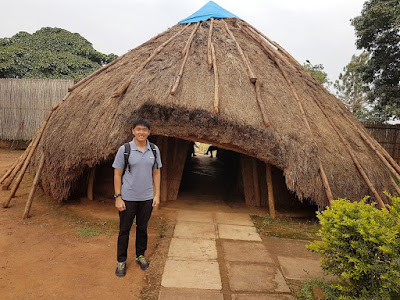Neftchilar Avenue, Baku, Azerbaijan
Baku Boulevard is a promenade that stretches along a south-facing bay on the Caspian Sea, which is the world's largest inland body of water. Established in 1909, the promenade was originally built to connect the oil fields in Bibi Heybet, a municipality in the capital city, as part of one of the urban development projects.

---
AZE: Baku Promenade <YOU ARE HERE!>
---
To reach the promenade, my BFF and I used one of the underground pedestrian walkways that are available throughout Baku, which provide the safest way to cross the heavy traffic roads.
 |
| The alluring aroma of buttered popcorn wafted in the air. |
 |
| Can't the Little Red Riding Hood immediately identify that the wolf isn't her grandma? |
Do you like flowers? I love them.
One of the most interesting sights at the promenade is the Crescent Development Project, which is still under construction at the point of writing. Fancy staying in a crescent-shaped hotel in the near future?


The seafront was artificially built up inch by inch.
 |
| I was certainly enjoying the cooling weather after not travelling overseas for more than two years. |
Until the early 20th century, there were no trees along the promenade.
 |
| A decree was passed in 1880s to mandate all ships entering from Iran to bring fertile soil to grow trees. |
 |
| There are a few snack kiosks along the promenade. |
It was only then I realised that I reached the country on its Independence Day: 28 May.
I'm sure you've been noticing the three flame-shaped buildings from a few of the photos shown earlier. Baku's Flame Towers are intended to symbolise the element of fire that's deeply associated with the country whose nickname is the Land of Fire.
 |
| The phrase is believed to refer to either the natural burning of the rich surface oil deposits or the oil-fueled fires in temples of the once-dominant Zoroastrianism. |
 |
Which one do you think is the tallest tower that stands at 182 m?
|
Built in 1960, Little Venice is a recreational area within Baku Boulevard that's made up of man-made waterways.
 |
| A gondola ride costs AZN 3.00 (~S$2.45) per person. |
International Mugham Center is a local institution that aims to preserve and promote the mugham genre of Azerbaijani music, which is a traditional musical form characterised by a large degree of improvisation.
Another point of interest is Azerbaijan National Carpet Museum that was first opened to the public in 1967, but it only moved to the current building in 2014.
Care for some dondurma (Turkish ice cream)?
A premier shopping mall, Deniz Mall offers five levels of entertainment, leisure, retail and F&B establishments.
 |
| Resembling a lotus flower, the building was designed by Chapman Taylor, a renowned English architectural firm. |
 |
| Back in mid-2022, a proof of vaccination was required to enter the shopping mall. |
Initially we were thinking of walking all the way to Baku Crystal Hall and National Flag Square, but they're much further than we thought.
 |
| Baku Crystal Hall is an indoor arena that was originally built to host the 2012 Eurovision Song Contest. |
 |
| The hall has got 12,000 seats, but it can accommodate up to 27,000 people. |
Standing at 60 m, Baku Eye is a Ferris wheel equipped with 30 enclosed cabins.
 |
| The Ferris wheel opened its doors to the public, or should I say cabins, in March 2014. |
Have a look at the eye-catching illumination.
As we were getting hungry, we decided to walk back after adoring the sight of Baku Eye.
 |
| I felt safe walking along the promenade at night. |
 |
| It was in 2012 that the promenade was extended all the way to National Flag Square. |
 |
| Once used for extreme activities until a fatal accident happened, Parachute Tower was erected in 1936. |
Stay tuned for the next post on Baku Eye, which shall also feature a few photos of Baku Boulevard during the day.


















































Comments
Post a Comment